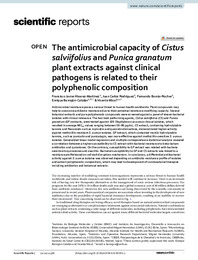Por favor, use este identificador para citar o enlazar este ítem:
https://hdl.handle.net/11000/34430
The antimicrobial capacity of Cistus salviifolius and Punica granatum plant extracts against clinical pathogens is related to their polyphenolic composition
Título :
The antimicrobial capacity of Cistus salviifolius and Punica granatum plant extracts against clinical pathogens is related to their polyphenolic composition |
Autor :
Álvarez-Martínez, Francisco Javier 
Rodríguez, Juan Carlos
Borras Rocher, Fernando 
Barrajón-Catalán, Enrique 
Micol, Vicente  |
Editor :
Nature Research |
Departamento:
Departamentos de la UMH::Ingeniería |
Fecha de publicación:
2021-01 |
URI :
https://hdl.handle.net/11000/34430 |
Resumen :
Antimicrobial resistance poses a serious threat to human health worldwide. Plant compounds may help to overcome antibiotic resistance due to their potential resistance modifying capacity. Several botanical extracts and pure polyphenolic compounds were screened against a panel of eleven bacterial isolates with clinical relevance. The two best performing agents, Cistus salviifolius (CS) and Punica granatum (GP) extracts, were tested against 100 Staphylococcus aureus clinical isolates, which resulted in average MIC50 values ranging between 50–80 µg/mL. CS extract, containing hydrolyzable tannins and flavonoids such as myricetin and quercetin derivatives, demonstrated higher activity against methicillin‑resistant S. aureus isolates. GP extract, which contained mostly hydrolyzable tannins, such as punicalin and punicalagin, was more effective against methicillin‑sensitive S. aureus isolates. Generalized linear model regression and multiple correspondence statistical analysis revealed a correlation between a higher susceptibility to CS extract with bacterial resistance to beta‑lactam antibiotics and quinolones. On the contrary, susceptibility to GP extract was related with bacteria sensitive to quinolones and oxacillin. Bacterial susceptibility to GP and CS extracts was linked to a resistance profile based on cell wall disruption mechanism. In conclusion, a differential antibacterial activity against S. aureus isolates was observed depending on antibiotic resistance profile of isolates and extract polyphenolic composition, which may lead to development of combinatorial therapies including antibiotics and botanical extracts.
|
Área de conocimiento :
CDU: Ciencias puras y naturales: Generalidades sobre las ciencias puras |
Tipo de documento :
info:eu-repo/semantics/article |
Derechos de acceso:
info:eu-repo/semantics/openAccess
Attribution-NonCommercial-NoDerivatives 4.0 Internacional |
DOI :
https://doi.org/10.1038/s41598-020-80003-y |
Publicado en:
Scientific Reports volume 11, Article number: 588 (2021) |
Aparece en las colecciones:
Artículos - Ingeniería
|
 La licencia se describe como: Atribución-NonComercial-NoDerivada 4.0 Internacional.
La licencia se describe como: Atribución-NonComercial-NoDerivada 4.0 Internacional.
 La licencia se describe como: Atribución-NonComercial-NoDerivada 4.0 Internacional.
La licencia se describe como: Atribución-NonComercial-NoDerivada 4.0 Internacional.
.png)
